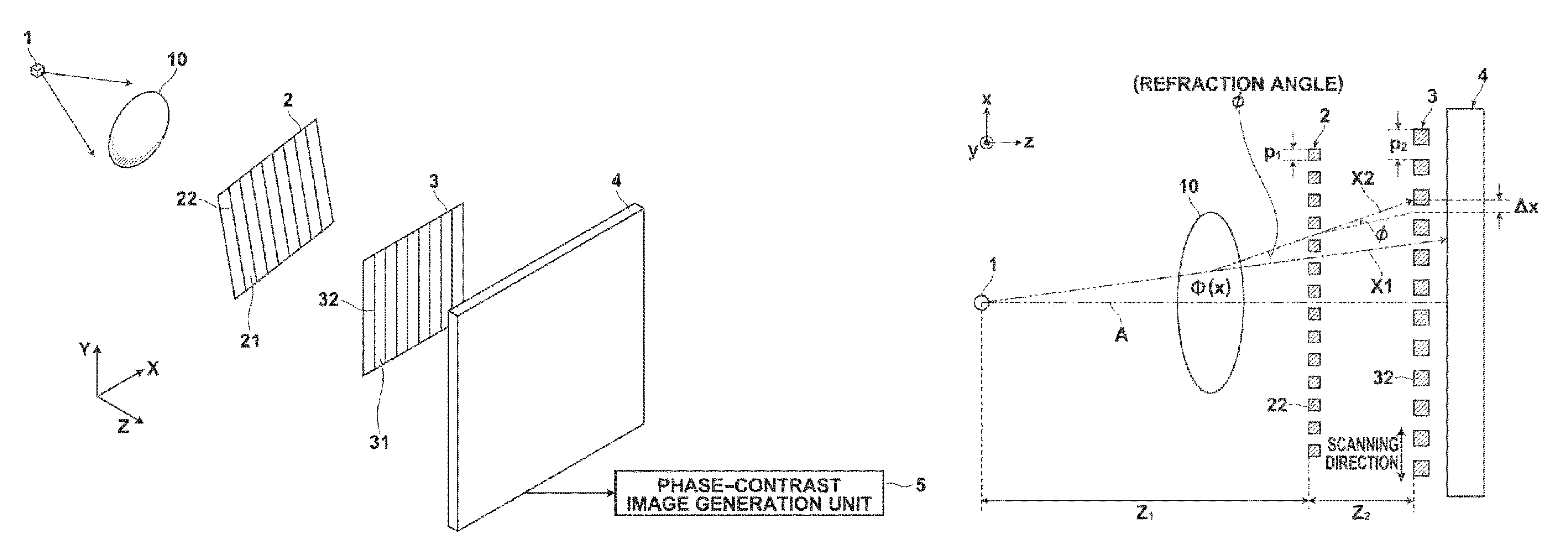Radiographic phase-contrast imaging apparatus
a phase-contrast imaging and phase-contrast technology, applied in the direction of instruments, patient positioning for diagnostics, applications, etc., can solve the problems of affecting the correct derivation of the positional relationship between the subject and the imaging system may be changed, and the difficulty in accurately deriving the phase variation of the x-ray generated, etc., to achieve the effect of high precision, increased cost and high precision
- Summary
- Abstract
- Description
- Claims
- Application Information
AI Technical Summary
Benefits of technology
Problems solved by technology
Method used
Image
Examples
first embodiment
[0179]Further, although the direction in which the second grating 3 extends is parallel to the Y-direction and the direction in which the self image G1 of the first grating 2 extends is inclined relative to the Y-direction by θ, as shown in FIG. 6, in the above-described first embodiment, the direction in which the self image G1 of the first grating 2 extends may be parallel to the Y-direction, and the direction in which the second grating 3 extends may be inclined relative to the Y-direction by θ.
[0180]Still further, the relative angle of rotation θ in the X-Y plane between the self image G1 of the first grating 2 and the second grating 3 may be expressed by Expression (21) below, in place of Expression (13), based on a relationship between a sub-pixel size Dsub and a period T of the moire pattern formed by the self image G1 of the first grating 2 and the second grating 3. In Expression (21) below, Z1 is a distance from the focal spot of the radiation source 1 to the first grating ...
second embodiment
[0188]Specifically, in the radiographic phase-contrast imaging apparatus of the second embodiment, both the first grating 2 and the second grating 3 are formed as absorption type (amplitude modulation type) gratings, and are adapted to geometrically project the radiation passed through the slits irrespectively of the Talbot interference effect. In more detail, values of the interval d1 of the first grating 2 and the interval d2 of the second grating 3 are set to be sufficiently greater than the effective wavelength of the radiation applied from the radiation source 1, so that the most part of the applied radiation forms the self image G1 of the first grating 2 behind the first grating 2 without being diffracted by the slits. For example, in the case where tungsten is used as the target of the radiation source and the tube voltage is 50 kV, the effective wavelength of the radiation is about 0.4 Å. In this case, by setting the interval d1 of the first grating 2 and the interval d2 of ...
PUM
| Property | Measurement | Unit |
|---|---|---|
| angle | aaaaa | aaaaa |
| energy | aaaaa | aaaaa |
| thickness h1 | aaaaa | aaaaa |
Abstract
Description
Claims
Application Information
 Login to View More
Login to View More - R&D
- Intellectual Property
- Life Sciences
- Materials
- Tech Scout
- Unparalleled Data Quality
- Higher Quality Content
- 60% Fewer Hallucinations
Browse by: Latest US Patents, China's latest patents, Technical Efficacy Thesaurus, Application Domain, Technology Topic, Popular Technical Reports.
© 2025 PatSnap. All rights reserved.Legal|Privacy policy|Modern Slavery Act Transparency Statement|Sitemap|About US| Contact US: help@patsnap.com



